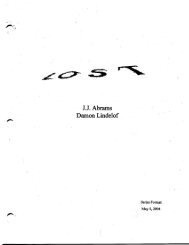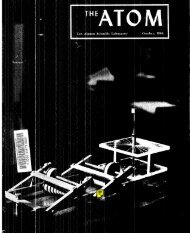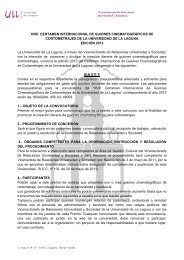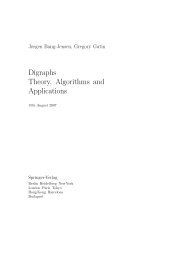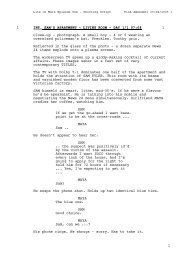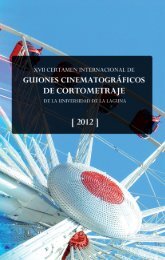Create successful ePaper yourself
Turn your PDF publications into a flip-book with our unique Google optimized e-Paper software.
a lubricant is formed primarily by<br />
friction. Then what kind of role do<br />
the skates play? It turns out we need<br />
them after all! Without going into<br />
the details of "skating physics," I'11<br />
point out one obvious fact: far less<br />
ice needs to be melted to lubricate<br />
the blade of a skate (whose surface<br />
area is rather small) than it takes to<br />
lubricate the sole of a boot.<br />
Are there any other phenomena<br />
where an substantial shift in the<br />
melting point of ice occurs? Most<br />
certainly. For example, consider the<br />
way a huge glacier overcomes obstacles<br />
as it creeps down a slope.<br />
Right where the glacier comes up<br />
against aboulder or outcrop/ agreat<br />
amount of pressure builds up, which<br />
causes the ice to melt. In a way the<br />
glacier flows around the stone and<br />
lets it pass through the ice. When<br />
the pressure drops, the water in the<br />
glacier freezes again.<br />
"This is all very interesting," you<br />
rr,ay sayr "but is that all you have to<br />
show for yourself?" Of course not.<br />
Let's take a closer look at our result.<br />
Now we can calculate the change in<br />
the equilibrium temperature of two<br />
phases-liquid (water) and solid<br />
(ice)-caused by a variation in external<br />
pressure. What's most remarkable<br />
is that we can apply the result<br />
to any other pair of phases, provided<br />
they are in thermal equilibrium-for<br />
example, liquid-vapor, metal-molten<br />
metal, solid-vapor, and so on. In other<br />
words, the Clapeyron-Clausius equation<br />
holds not only for melting, but<br />
for any process involvirrg the transition<br />
o{ a substance from one phase<br />
to another (evaporation, sublimation,<br />
and so on). For these processes<br />
we need to modify equation (2) with<br />
the corresponding values for the<br />
densities of the substance in the two<br />
phases and the latent heat for the<br />
phase transition.<br />
By way o{ example, let's look at<br />
the transition of water to vapor. As<br />
you know, vapor that is at equilibrium<br />
with water is called "saturated."<br />
The relation between the<br />
temperature of the saturated vapor<br />
and its pressure is used to calculate<br />
atmospheric humidity, the dew<br />
point, and so on. In addition, the<br />
Figure 3<br />
temperature of saturated vapor (that<br />
is, the equilibrium temperature in<br />
the water-vapor system) determines<br />
the boiling point of water at a given<br />
external pressure. Thus, at a pressure<br />
of I atm, the boiling point is<br />
100'C (373 K). Coming at it from the<br />
other direction, we know that the<br />
pressure of saturated vapor increases<br />
with temperature. This phenomenon<br />
constitutes the working principle<br />
of the pressure cooker, which<br />
cooks food at a higher temperature<br />
and greater pressure.<br />
What's the difference between<br />
the melting of ice and the evaporation<br />
of water? Why does the equilibrium<br />
temperature drop with an increase<br />
in pressure in the one case,<br />
and rise in the other? There's another<br />
factor involved: volume.<br />
When ice absorbs heat and melts,<br />
the volume of the system decreases<br />
(the density of water is greater than<br />
that of ice), but when water absorbs<br />
heat and evaporates/ the volume of<br />
the system increases (the density of<br />
saturated vapor is less than that of<br />
water). However, in both cases the<br />
graph for the cycle must move<br />
clockwise in theP-V coordinate system-otherwise<br />
the work performed<br />
by the Camot engine would be negative.<br />
Compare the trajectories of<br />
both plots (figures 2 and 3l and you<br />
can see why for one of them a lower<br />
temperature corresponds to a greater<br />
pressure/ while the opposite occurs<br />
in the other case. In addition, try to<br />
find the sequence of actions you<br />
need to perform with a vessel containing<br />
water and vapor in order to<br />
obtain the Carnot cycle shown in<br />
the graph.<br />
To put a cap on our story, let's<br />
calculate the shift in the boiling<br />
point caused by a pressure increase<br />
from 1.00 to 1.01 atm. We replace<br />
v<br />
the latent heat of fusion for ice in<br />
equation (2) with the latent heat of<br />
vapoization Iu, and the density of<br />
ice with the density of saturated va-<br />
Por Pv:<br />
/\<br />
I<br />
-ll<br />
^r=^PLl r' [P, P* )<br />
The density of saturated water vapor<br />
at T = 373 Kand P = 1 atm can be<br />
found from the Clapeyron-Mendeleyev<br />
equation:<br />
p,, = P-Y= 0.58 kg / ,,,t.<br />
'R7<br />
Substituting numerical data, we get<br />
LT O.28 K for AP =<br />
= 0.01 atm.<br />
As you can see, in this case the<br />
phenomenon is quite pronounced:<br />
to increase the boiling temperature<br />
by 1 K, we need to increase the pressure<br />
by a mere 0.035 atm, which is<br />
perfectly feasible even under ordinary<br />
conditions. o<br />
Ihs, you calt UEI<br />
[ac[ issue$ ol<br />
,. ..:.,,,",,,,,'..i i,-,:l :.*,<br />
I !<br />
Quantum began publication<br />
with the )anuary<br />
1990 pilot issue. All back<br />
issues of Quantum (except<br />
September/October<br />
1990, which is out of<br />
print) are available for<br />
purchase. For more information<br />
and prices, call<br />
1 800 777-4643<br />
or send your order to<br />
QuantumBacklssues<br />
Springer-Verlag<br />
PO Box2485<br />
Secaucus NJ 07094<br />
0llrilrt|fir/AI IIt 0r.Icr(80AR0 I 27



